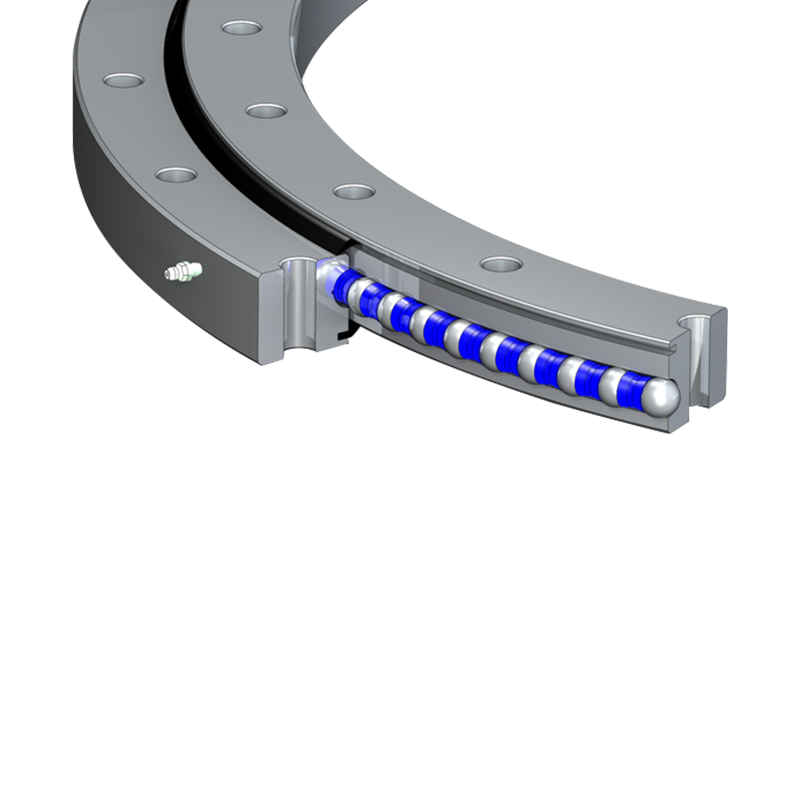What type of lubrication is recommended for single-row ball slewing bearings?
 2025.02.21
2025.02.21
 Industry news
Industry news
1. Types of Lubricants
A. Grease Lubrication
Recommended for most applications : Grease is the most common lubricant used for single-row ball slewing bearings, especially in slow to moderate-speed applications.
Advantages :
Provides long-lasting lubrication with minimal maintenance.
Acts as a sealant to prevent contamination (e.g., dust, dirt, moisture) from entering the bearing.
Suitable for intermittent or oscillatory motion, which is typical in slewing bearing applications.
Common Grease Types :
Lithium-based grease : General-purpose grease with good water resistance and temperature stability.
Calcium sulfonate grease : Offers excellent corrosion resistance and high load-carrying capacity, making it ideal for harsh environments.
Synthetic grease : Designed for extreme temperatures, heavy loads, or high-speed applications.
EP (Extreme Pressure) grease : Contains additives to prevent metal-to-metal contact under high loads, making it suitable for heavy machinery like cranes and excavators.
B. Oil Lubrication
Recommended for high-speed or continuous-motion applications : Oil lubrication is less common for slewing bearings but may be used in applications where heat dissipation or continuous lubrication is required.
Advantages :
Better heat dissipation compared to grease.
Suitable for high-speed or high-temperature environments.
Disadvantages :
Requires more frequent replenishment and a reliable sealing system to prevent leakage.
Less effective at preventing contamination compared to grease.
Oil Types :
Mineral oil : General-purpose oil for moderate conditions.
Synthetic oil : For extreme temperatures or heavy-duty applications.
EP oils : Contain additives to handle high loads and prevent wear.
2. Factors Influencing Lubricant Selection
A. Operating Conditions
Speed :
Grease is preferred for low-speed or oscillatory motion.
Oil is better suited for high-speed applications.
Load :
EP greases or oils are recommended for heavy loads to prevent metal-to-metal contact.
Temperature :
Synthetic lubricants are ideal for extreme temperatures (both high and low).
Standard greases may degrade at high temperatures or become too viscous at low temperatures.
B. Environment
Moisture Exposure :
Use water-resistant greases (e.g., lithium or calcium sulfonate) in wet or humid environments.
Dust and Contaminants :
Grease provides better protection against contaminants compared to oil.
Corrosive Environments :
Use corrosion-resistant greases or oils with anti-corrosion additives.
C. Application-Specific Requirements
Wind Turbines :
Specialized greases with excellent water resistance and low-temperature performance are often used.
Construction Machinery (e.g., Cranes, Excavators) :
EP greases are commonly used due to the high loads and exposure to dirt and moisture.
Marine Applications :
Marine-grade greases with superior water resistance and corrosion protection are essential.

3. Lubrication Frequency
Grease Lubrication :
The frequency of re-greasing depends on the operating conditions, load, speed, and environmental factors.
In general, re-greasing intervals range from every 6 months to every 2 years for standard applications.
For heavily loaded or contaminated environments, more frequent lubrication may be required.
Oil Lubrication :
Continuous oil circulation systems are often used in high-speed applications.
Oil levels should be monitored regularly, and filters should be maintained to remove contaminants.
4. Best Practices for Lubrication
Proper Amount of Lubricant :
Over-lubrication can lead to overheating and increased friction, while under-lubrication can cause premature wear.
Follow the manufacturer’s recommendations for the correct amount of grease or oil.
Cleanliness :
Ensure that the bearing and surrounding area are clean before applying lubricant to avoid introducing contaminants.
Sealing System :
Use high-quality seals or shields to protect the bearing from contamination and retain the lubricant.
Compatibility :
Ensure that the new lubricant is compatible with any residual lubricant in the bearing to avoid degradation or separation.
Monitoring :
Regularly inspect the bearing for signs of inadequate lubrication, such as excessive noise, vibration, or overheating.
5. Special Considerations
A. Self-Lubricating Bearings
Some single-row ball slewing bearings are designed with self-lubricating features , such as embedded solid lubricants or coatings. These are ideal for applications where regular maintenance is difficult or impractical.
Examples include bearings with PTFE (Teflon) coatings or graphite-based lubricants.
B. Automated Lubrication Systems
For applications requiring frequent lubrication, automated grease or oil dispensing systems can be installed to ensure consistent lubrication without manual intervention.
C. Environmental Regulations
In some industries (e.g., food processing, marine), environmentally friendly or biodegradable lubricants may be required to comply with regulations.












